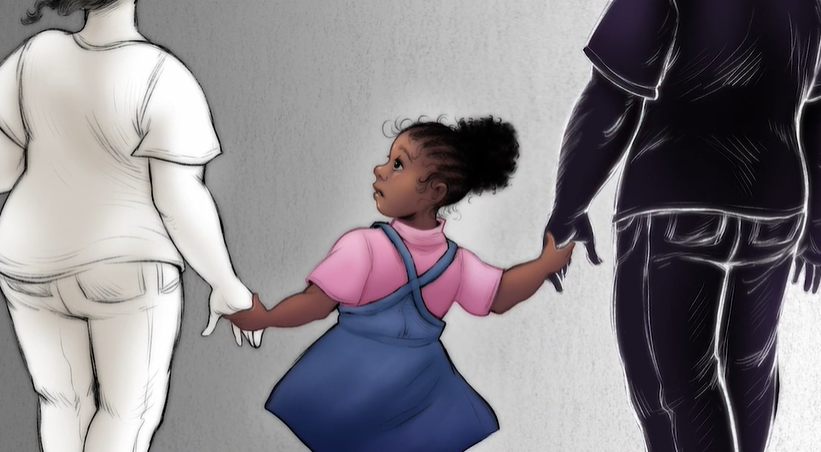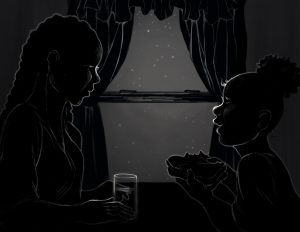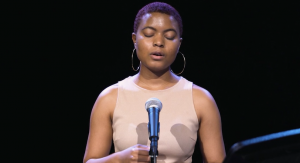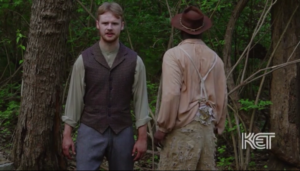Featured image: Artwork showing a Black-appearing toddler standing between a man and a woman. She holds both of their hands but looks towards the woman. The entire scene is in black and white except for the toddler. Her skin is brown. She wears a denim dress and a pink t-shirt. The mother is completely washed in white. The father is completely washed in black. Artwork created by Aspen Kowsky, courtesy of Mourning the Creation of Racial Categories Project.
Mourning Racial Categories is a four-part series discussing four films that have been created as part of the Mourning the Creation of Racial Categories Project. This project engages the visual and performing arts to tell the stories of how people in the United States were divided into a handful of unequally valued racial categories, such as Asian, Black, and White. MCRC offers a language for the trauma suffered by our country, communities, and relationships caused by the formation of these categories.
The Mourning the Creation of Racial Categories Project (MCRC) was started by Joan Ferrante, professor of sociology at Northern Kentucky University. While teaching classes on race, Joan found that her students had a difficult time engaging in meaningful conversations about race even though they bore the weight of the classifications themselves. Academia alone did not offer students the language to unpack their relationship with their racial classifications so she put together a team of students and faculty in the creative and performing arts to collaborate to create projects that would engage people with race.
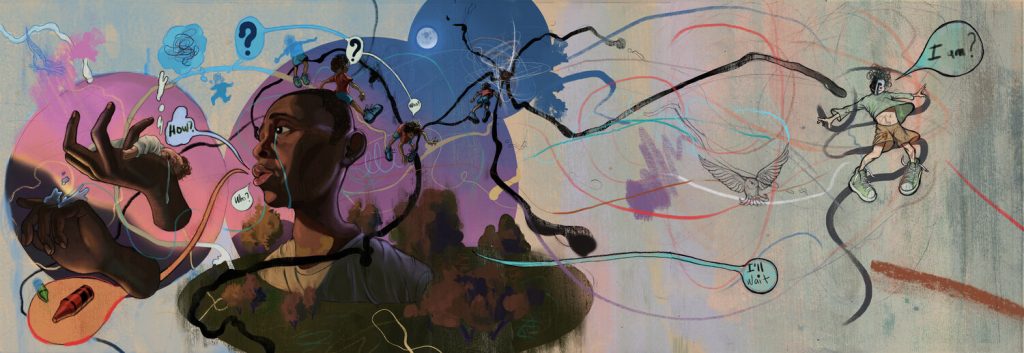
In June of 2021, I’m White Like You, Right Mom? premiered at the 19th annual Cincinnati Fringe Festival. Part one of MCRC’s latest short film duology, I’m White Like You, Right Mom?, explores the felt separation and uncomfortable realizations that come about when a child is classified as a different race than one of their parents. The film’s central conflict is between a mother and a daughter. The mother is a white woman married to a Black man and together they have a Black classified child. When one day the child says to her mother, “I’m white like you, right?” the mother struggles to give her daughter a comprehensive answer, as she isn’t sure herself. When she turns to her Black friend for help she instead comes face to face with a man who calls himself “The White Category.” The film juxtaposes the present reality—white mother, Black daughter—with the past by telling the story of a white woman whose Black grandchildren are only able to have freedom because of their relationship to her. It uses this story, interspersed with poems and art pieces, to speak to an ever-present phenomenon. It urges both characters and audience members to ask themselves how we can begin to explain the complexities of race to a child when we struggle to understand it ourselves.
The film opens on the actor Geoffrey Hill seated in a dark room. He recites the poem “Letter To My Son” by India Hackle:
“At three years old we were coloring a different world with purple suns and blue birds / We could’ve been red together / Or pretended to have brown and beige crayons but you separated us / You said daddy I am white and you’re Black.”
The poem was inspired by a letter written by MCRC participant Jibril-Iman McCaster to his biracial son.
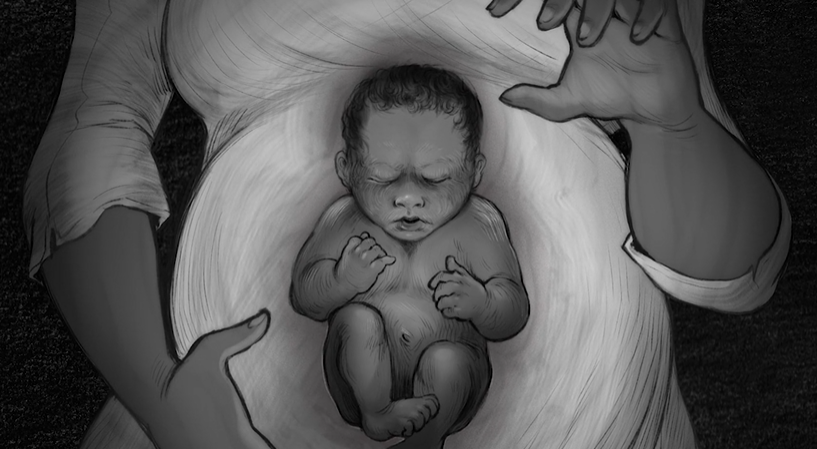
Before watching the film, I spoke with poet and development editor India Hackle and MCRC project founder Joan Ferrante about the content of the film and the processes leading to its creation. A large part of the film was created during the quarantine in 2020 and 2021, and so creating the film was a uniquely collaborative experience.
Joan Ferrante speaks of this scene where the poem “Letter To My Son” is read:
“I had a student [who] has a son that said, “I’m white and you’re Black.” Before he knew what colors were, he had them down in black and white. [The poem] opens and ends the film I’m White Like You, Right Mom?. [Artist] Sherman Parnell makes [the story] into an artwork. India Hackle makes it into a poem.”
India Hackle describes the process of turning a father’s letter to his son into a poem, and then into a piece of art:
“I was partnering with the actual father, I took his letter to his son. I’m feeding [Sherman Parnell] as much background information as I can so that the [artwork he was creating] could be completed. [He showed me] his work [so that I could] look at it before it’s done so we could keep collaborating [throughout the creation of the piece]. I think that’s what makes it work—we’re feeding each other trying to get the pieces to speak to each other. Instead of, oh, here’s my poem. And then, oh, here’s my art piece. Either they speak to each other or they don’t, you only get one try with that versus with collaborating, you’re going back and forth.”
The poem’s impassioned words are interspersed with images of a painting created by artist Sherman Parnell. In the painting, a man holds his child in his oversized hands while at the same time watching the child float over and away from him. Colors swirl on the screen like the ones described in the poem; the ones that make purple suns and blue birds, but separate them. Floating in the air between father and son are the words “Who?” and “How?”.
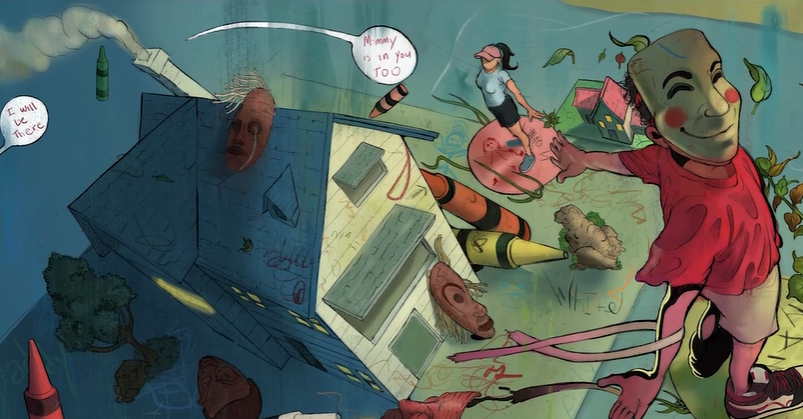
The scene fades to black. Next we open onto trauma therapist La Shanda Sugg as she expands on the poems’ themes. In the film, she says, “There was a hopefulness in the father that we wouldn’t have to go here, that we could just be—there is a continual narrative that parent and child are impacted by this system just as much as everyone else.”
With her words lingering like a ghost, we open onto another dark and vacant room, entirely barren but for a black chair and table with a closed laptop on top. A white-appearing woman enters, sits at the table, and opens the laptop. On the screen is a Black-appearing woman. The friend says, “Hello,” and the other woman bursts into a story about an uncomfortable question her daughter had asked her recently.
“Mommy, I’m white like you, right?” She says, “I had no idea what to say.” The mother goes on to explain how she gave an awkward explanation to her six year old daughter, explaining that she’s not “exactly white…she’s Black and white.” She also expands on her fear that her answer drew a permanent line between herself and her daughter. In the middle of her grievances a new face breaks onto the screen. It appears to be an older white man dressed in a white collared shirt with gray hair and beard. Instead, it is the allegorical ‘White Category’ who proudly pronounces his namesake to the disturbed woman.
“I’m the divide you and your daughter fight against everyday.”
“My daughter and I don’t fight a divide. We love each other.”
What follows is both an intense debate and a reluctant education wherein a mother is implored to acknowledge the divide that exists between herself and her daughter because of their racial classifications, despite their love for each other. What is highlighted is the juxtaposition between a mother and daughter’s connection to each other and the reality of their apparent differences as well as the subsequent difference in experiences that her Black-appearing daughter will have. And even as the mother purports that her daughter is proof of the fact that she and her husband have conquered the racial divide, she cannot help but be taken in by the words of the ‘White Category’.
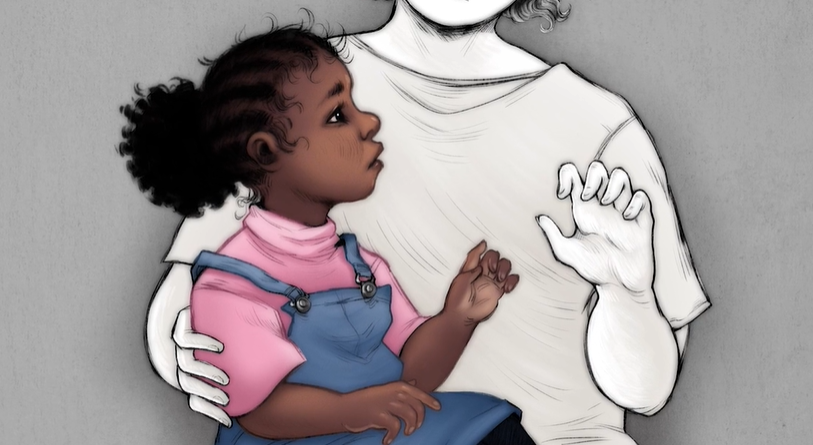
The ‘White Category’ compares the mother’s situation to that of an English-Irish woman named Mary Madden, who in 1757 had a baby with a Negro-classified man and had a baby named Sarah. “You’re nothing special, that line has been crossed millions of times. But it’s the punishment for crossing the lines that make the Black-white divide matter.” The punishment for a free English woman that has a child with a Negro or mulatto-classified male was fifteen pounds sterling at the time and the child was to be forced into indentured servitude. In the film, a performance by Sally Modzelewdski and Maiya Caldwell shows the enduring consequences that Mary faced.
“She cost fifteen pounds to keep / I only had ten.”
Sarah was taken at two years old and she never saw her mother again.
“They came for her and her cries scattered across my collarbone. / left residue then faded.”
The antiquity of this tragic story makes it easy for the mother in the present day to distance herself from Mary Madden’s plight. She says as much, “This is a really sad story, but it’s not my story. Nobody can take my baby away from me these days for having a baby with a Black man.” But the ‘White Category’ personified points to the separation that can exist within a family or even an individual with parents of different racial categories. “You’re right, these days no one can take your daughter, but nevertheless racial categories can separate the two of you. Our European ancestors made it impossible for Black and white to co-exist peacefully in one body.” His statements expose a wound that lingers despite a society that claims to accept and revere diversity.
Kerry Ann Rockquemore, founder of the National Center for Faculty Development & Diversity, and David L. Brunsma, a professor at the Virginia Tech Department of Sociology, described this very identity issue in the article “Socially Embedded Identities: Theories, Typologies, and Processes of Racial Identity among Black/White Biracials.” “The multiracial experience has been depicted in social science research, American literature, and popular culture as one of ‘betweenness’ and ‘marginality.’ Uncertainty, confusion, and tragedy have characterized the lives of biracial people as they straddle the volatile and shifting racial divide in the United States.”
In the film, La Shanda Sugg expands on the lasting effects of these laws: “I think if a system existed where both [Black and white could exist peacefully in one body], systemically it wouldn’t be so difficult because we would have words and we would have a narrative, and we would have a realized truth of millions of people. But because the system has been created to isolate whiteness here and other things elsewhere, you come up with a lack of words and an inability for both those things to be true—even though they are. How do you acknowledge this child’s reality in a system that denies that very reality and [denies] how devastating that is for a parent and their child?”
The ‘White Category’ cites a similarity between the woman’s daughter and Sarah: a fear of their parentage being confirmed. “These days no one can take your daughter away, but nevertheless racial categories can separate the two of you.” An actress performs a poem as Mary’s daughter, Sarah. She crouches on the ground and says, “I used grass to cover our dirt family but someone must’ve found us because I never saw mama again.”
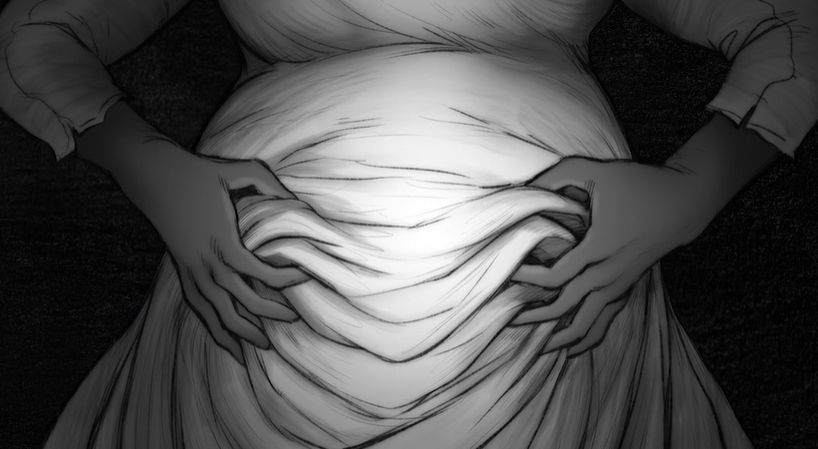
The mother in the present day seems to be newly distressed by this recitation of events, their relevance today, and how she has unknowingly become a part of the narrative the moment her daughter came into the world.
She says imploringly, “I shouldn’t have to pay for this history I didn’t create. My relationship with my daughter should not have to suffer.”
The ‘White Category’ responds, “I’m glad you think race shouldn’t matter,” then leaves abruptly.
While the mother is still reeling from her discoveries, the friend reappears on the screen. She says, “Look, the point is, you’re defensive about your Black husband and you’re insecure about your daughter and Leah, even at six years old, can pick up on it. You freak out whenever Leah asks you a question and then come running to me looking for answers with anything that has to do with Black. This isn’t just something for your husband or your daughter to wrestle with, you have to wrestle with it, too. I can’t lift the weight for you. This is your family.”
Near the end of the film, La Shanda Sugg reflects on the themes of the poem and the film as a whole”
“Sometimes there are no words. When we talk about having conversations about race or having conversations about categories, often we find ourselves at a point where [we] won’t know what to say. That’s why providing some of the stories and the narratives that have existed historically and opening up places for people to [have] dialogue [about it] can allow us to start having the opportunity to formulate words to go along with the experiences that are being had.”
The film ends where it began, with Geoffrey Hill’s recitation of “Letter To My Son.”
“I will be there / To point to the rupture of us.”

Ariel Yisrael is an Ohio-based freelance writer and poet with a mission to report the therapeutic value of the arts specifically for underrepresented members of a community. A recent graduate of Northern Kentucky University, she uses her experience in creative writing to explore topics of physical and mental health and wellness.
